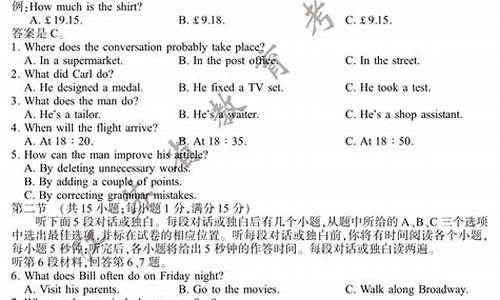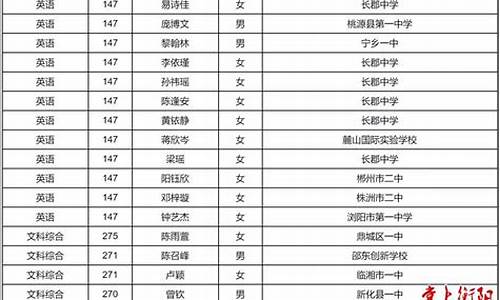您现在的位置是: 首页 > 教育资讯 教育资讯
高中英语从句高考真题,江苏英语高考从句
tamoadmin 2024-06-08 人已围观
简介1.高考英语语法:高中英语语法-浅谈虚拟语气的特殊用法2.高考英语语法:高中英语语法-as 引导的各种从句之一3.高考英语从句的选择题,怎么答啊!4.高考英语:Having spent one week on history and____three weeks on the other subjects,5.高考英语语法的考点都有哪些6.高考英语状语从句问题7.求对英语名词性从句的详细总结,高考
1.高考英语语法:高中英语语法-浅谈虚拟语气的特殊用法
2.高考英语语法:高中英语语法-as 引导的各种从句之一
3.高考英语从句的选择题,怎么答啊!
4.高考英语:Having spent one week on history and____three weeks on the other subjects,
5.高考英语语法的考点都有哪些
6.高考英语状语从句问题
7.求对英语名词性从句的详细总结,高考用

1. 基本用法
定语从句除可用关系代词引导外,还可用关系副词when, where与why来引导,它们的区别是:when用于指时间,where用于指地点,why用于指原因。when, where, why 在定语从句中均用作状语。如:
1980 was the year when he was born. 1980是他的出生年。
This is the town where I was born. 这就是我出生的城市。
These are the reasons why we do it. 这些就是我们这样做的理由。
2. 先行词问题
关系副词when和where的先行词是表示时间(如the day, the days, the time, the year等)和地点(如the place, the house, the factory, the station等)的一类词,而关系副词why的先行词通常只是the reason(s)。另外,when和where可引导限制性和非限制性定语从句,而why则只用于引导限制性定语从句,不用于引导非限制性定语从句。
3. 一点注意
注意不要以为在时间名词后就一定用关系副词when,在地点名词后就一定用关系副词 where,在表示原因的the reason后就一定用关系副词why。到底选用关系副词还是关系代词,关键是看它们在定语是用作状语(用关系副词)还是用作主语或宾语(用关系代词)。如:
Don’t forget the time (that) I’ve told you. 不要忘记我告诉你的时间。(that用作told的宾语)
I’ll never forget the days when I worked with you. 我永远不会忘记我与你共事的日子。(when用作状语)
He works in a factory that [which] makes radio parts. 他在一家制造无线电零件的工厂工作。(that, which 在从句中用作主语,且不能省略)
He works in the factory where his father worked. 他在他父亲工作过的那家工厂工作。(where作状语)
That’s the reason that [which] he explained to us. 那就是他向我们解释的理由。(that或which在从句中用作explained的宾语)
That’s the reason why she left home. 那就是她离家出走的原因。(where在从句中作状语)
4. 一个错点
英语中的关系副词主要是 when, where, why三个。不要想当然地将how用作关系副词修饰the way。如不说 This is the way how he spoke,可改为 This is how he spoke(how引导的是表语从句),当然也可说成 This is the way (that, in which) he spoke.(其中的that, in which可省略
高考英语语法:高中英语语法-浅谈虚拟语气的特殊用法
宾语从句和定语从句的区别:宾语从句:只有主语+谓语动词,缺少宾语,整个从句充当句子宾语,(从句前面是一个动词)。定语从句是:主谓宾完整,整个从句作为定语补充说明宾语这个先行词,(从句前面是一个名词)。
定语从句结构
定语从句公式:定语从句=先行词+关系词+从句
先行词,指被定语从句修饰的名词、代词。
一般先行词出现在定语从句的前面。
关系词
关系词常有3个作用:
①连接作用,连接主句和定语从句。
②指代先行词。
③在定语从句中担当成分。
宾语从句时态
主句是一般现在时,从句根据实际情况使用任何时态。
例句:The headmaster hopes everything goes well.
主句是一般过去时,从句须用过去时态的某种形式。
例句:She was sorry that she hadn’t finished her work on time.
当宾语从句表示的是一个客观真理或者事实真理时,即使主句是过去时,从句也用一般现在时态。
例句:The teacher told his class that light travels faster than sound.
高考英语语法:高中英语语法-as 引导的各种从句之一
《高中英语语法-浅谈虚拟语气的特殊用法》由英语我整理,更多请访问:。本内容整理时间为05月12日,如有任何问题请联系我们。
浅谈虚拟语气的特殊用法
1. 当虚拟条件从句中的谓语动词和主句中的谓语动词发生的时间不一致时,主句和从句的谓语动词应根据实际的时间选用适当的动词形式。如:
If you had earned enough money,you would live a happy life in the future.
如果你已挣了足够的钱,你今后就会过上幸福的生活。
(从句与过去事实相反,谓语动词用过去完成时;主句与将来事实相反,谓语动词用? would/should/could/might+ 动词原形?。)
2. 在虚拟语气中,有时假设的情况并不是以条件状语从句的形式表示,而是通过相应的介词或连词来表示,如 without, but for, or, but, otherwise 等。如:
But for your help,we couldn?t have finished the task in time. (= If you hadn?t helped us? tomorrow?)
要不是你的帮助,我们就不会按时完成任务。
3. 在 if 引导的虚拟条件句中,如果条件状语从句位于句首,且从句中含有 were, had 或 should ,则可以省略 if ,并用倒装结构。如:
Should it rain tomorrow,we would have to stay at home. (= If it should rain tomorrow?)
如果明天下雨,我们就得呆在家里。
4. 如果主句中含有 would rather, would as soon, would sooner 或 would prefer ,则从句要用过去时表示当时或将来的情况,用过去完成时表示过去的情况,表达希望或婉转的责备。如:
I would prefer he worked hard.
我倒希望他能够努力学习。
I would just as soon you had returned the book yesterday.
我真希望你昨天把这本书还了。
5. 在? It?s (high/ about) time + that 从句?中, that 从句的谓语动词要用虚拟语气,表示?是该?的时候了?,其形式为一般过去时或? should + 动词原形?,但 should 不能省略。如:
It?s time that we began our meeting.
是该开会的时候了。
It is high time that we should tell him the truth.
是我们该告诉他真相的时候了。
6. 在表示建议、命令、要求、坚持( suggest , order , demand , propose , request , command , insist )等相关的名词性从句中,谓语动词要用虚拟语气? (should) + 动词原形?。如:
The order that we should reach the small village before daybreak came just now.
要求我们在天亮之前赶到小村庄的命令刚刚下达。(同位语从句)
The suggestion is that we (should) recite a passage each day.
建议是我们每天应背诵一篇短文。(表语从句)
It is demanded that we (should) get everything ready by tonight.
我们被要求今晚之前把一切都准备好。(主语从句)
7. 在? It is + 形容词 + that 从句?中,从句的谓语动词要用虚拟语气? (should) + 动词原形?。这类形容词有 necessary, important, essential, strange, natural 等。如:
It is necessary that he (should)be sent to the hospital at once.
立刻送他进医院是非常必要的。
8. 由 wish 引起的表示愿望的宾语从句,其谓语要用虚拟语气。当 wish 表示的是与现在或当时事实相反的愿望时,它所引起宾语从句的谓语动词要用一般过去时或过去进行时;当 wish 表示的是与过去事实相反的愿望时,它所引起宾语从句的谓语动词要用过去完成时;当 wish 表示的是将来难以实现的愿望时,它所引起宾语从句的谓语动词要用? would/ should/ could/ might + 动词原形?。如:
I wish I had enough money to buy a car.
我希望能有足够的钱来买一辆小汽车。(表示的是现在)
He whishes he had not lost the chance.
他真希望没有失去机会。(表示的是过去)
I wish I would join the army when I grow up.
我希望长大后能够参军。(表示的是将来)
9. 在 insist 和 suggest 后的宾语从句中常用虚拟语气表示建议、要求或命令。但当 insist 表示?坚称;主张?时,宾语从句要用陈述语气;当 suggest 表示?表明;暗示?时,宾语从句也要用陈述语气。如:
She insisted that she had seen a thief climb into the house through the window.
她坚持说她曾看见一个小偷从窗口爬进了房间。
The smile on his face suggested that he had passed the exam.
他脸上的微笑表明他已通过了考试。
10. 在 as if / as though 引导的状语从句表示的是非真实情况时,从句的谓语动词要用过去时或过去完成时。如:
She talked about the film as if she had really seen it.
她谈论那部影片,就好像她确实看过一样。
安徽?梁静渊 《高中英语语法-浅谈虚拟语气的特殊用法》由英语我整理,更多请访问: style="font-size: 18px;font-weight: bold;border-left: 4px solid #a10d00;margin: 10px 0px 15px 0px;padding: 10px 0 10px 20px;background: #f1dada;">高考英语从句的选择题,怎么答啊!
《高中英语语法-as 引导的各种从句之一》由留学英语组我整理(www.liuxue86.com)。本内容整理时间为05月12日,如有任何问题请联系我们。
as 引导的各种从句之一
as 作为英语中一个非常活跃的词,其引导的从句在中学阶级较为多见,它们的种类应根据实际意义具体分析判定。笔者现将 as 引导的从句归纳并说明如下:
一、 as 充当连词,引导状语从句。
1. 引导时间状语从句,主句动作与从句动作同时发生,译为?当?的时候;一边?一边?。如:
As the students watched him quietly, he mixed the three together.
当学生们静静地看着他的时候,他把这三种液体搅和在一起。
As the pupils walked along the lake, they sang happily.
学生们沿着湖一边走,一边高兴地唱着。
2. 引导原因状语从句,从句所表达的原因是比较明显的,已为人们所知的。如:
As he did not know much English, he got out his dictionary and looked up the word ? cough ? .
由于他英语懂得不多,就拿出字典来查?咳嗽?这个词。
As it was getting very late, we soon turned back.
因为很晚了,我们很快就回来了。
3. 引导方式状语从句,此时 as 可译为?如;像;按照?。如:
Remember, you must do everything as I do.
记住,你们都要照我这样做。
When at Rome do as the Romans do.
(谚语)入乡随俗。
I have changed it as you suggested.
我已经按照你的建议把它改好了。
4. 引导让步状语从句,多用于书面语中,且须用部分倒装语序,即将从句的表语或状语等前置。它比 though 和 although 引导的让步状语从句更有表现力,语气更强。如:
Poor as he was (= Though he was poor ) he was honest.
他虽然贫穷,但很诚实。
Child as she is, she speaks English well.
虽然她是个孩子,但英语却讲得很好。
Fast as you read, you can't finish the book in two days.
尽管你读得很快,但你不能在两天内读完这本书。
5. 引导比较状语从句,从句通常可采用省略形式, as 译为?像?一样?。如:
It isn't as ( so ) cold as it was yesterday.
今天不像昨天那么冷。
二 . as 充当关系代词,引导定语从句
1. 引导限制性定语从句,在从句中作主语、宾语、表语等成分,先行词通常被 such, the same 所修饰,构成? such ? as, the same ? as ?结构。如:
You made the same mistake as ( you did ) last time.
你犯了和上次一样的错误。
You must show my wife the same respect as you show me.
你必须尊敬我的妻子,像你尊敬我一样。
Such women as knew Tom ( = Those women who knew Tom ) thought he was charming.
认识汤姆的女人都认为他很有魅力。
2. 引导非限制性定语从句, as 所代表的不是主句中的某个名词或代词,而是整个主句。 as 可放在主句前面或后面。如:
As is known to all, Taiwan is part of China.
众所周知,台湾是中国的一部分。
As we have seen, oceans cover more than 70 percent of the earth.
我们知道,海洋占地球面积的 70 %以上。
摘自 中学生英语读写
as 引导的各种从句
湖南长沙市第十八中学 雷玉兰
as 作为英语中一个非常活跃的词,其引导的从句在中学阶级较为多见,它们的种类应根据实际意义具体分析判定。笔者现将 as 引导的从句归纳并说明如下:
一、 as 充当连词,引导状语从句。
1. 引导时间状语从句,主句动作与从句动作同时发生,译为?当?的时候;一边?一边?。如:
As the students watched him quietly, he mixed the three together.
当学生们静静地看着他的时候,他把这三种液体搅和在一起。
As the pupils walked along the lake, they sang happily.
学生们沿着湖一边走,一边高兴地唱着。
2. 引导原因状语从句,从句所表达的原因是比较明显的,已为人们所知的。如:
As he did not know much English, he got out his dictionary and looked up the word ? cough ? .
由于他英语懂得不多,就拿出字典来查?咳嗽?这个词。
As it was getting very late, we soon turned back.
因为很晚了,我们很快就回来了。
3. 引导方式状语从句,此时 as 可译为?如;像;按照?。如:
Remember, you must do everything as I do.
记住,你们都要照我这样做。
When at Rome do as the Romans do.
(谚语)入乡随俗。
I have changed it as you suggested.
我已经按照你的建议把它改好了。
4. 引导让步状语从句,多用于书面语中,且须用部分倒装语序,即将从句的表语或状语等前置。它比 though 和 although 引导的让步状语从句更有表现力,语气更强。如:
Poor as he was (= Though he was poor ) he was honest.
他虽然贫穷,但很诚实。
Child as she is, she speaks English well.
虽然她是个孩子,但英语却讲得很好。
Fast as you read, you can't finish the book in two days.
尽管你读得很快,但你不能在两天内读完这本书。
5. 引导比较状语从句,从句通常可采用省略形式, as 译为?像?一样?。如:
It isn't as ( so ) cold as it was yesterday.
今天不像昨天那么冷。
二 . as 充当关系代词,引导定语从句
1. 引导限制性定语从句,在从句中作主语、宾语、表语等成分,先行词通常被 such, the same 所修饰,构成? such ? as, the same ? as ?结构。如:
You made the same mistake as ( you did ) last time.
你犯了和上次一样的错误。
You must show my wife the same respect as you show me.
你必须尊敬我的妻子,像你尊敬我一样。
Such women as knew Tom ( = Those women who knew Tom ) thought he was charming. 《高中英语语法-as 引导的各种从句之一》由留学英语组我整理(www.liuxue86.com)
高考英语:Having spent one week on history and____three weeks on the other subjects,
看这些词是定语从句吧。。。
that既可代表事物也可代表人,which代表事物;它们在从句中作主语或宾语,that在从句中作宾语时常可省略关系词,which在从句中作宾语也可以省略。[eg:this is the book (which)you want。]而且,如果which在从句中作“不及物动词+介词”的介词的宾语,注意介词不要丢掉,而且介词总是放在关系代词which的前边,但有的则放在它原来的位置
2. which作宾语时,根据先行词与定语从句之间的语义关系,先行词与which之间的介词不能丢
3. 代表物时多用which,但在带有下列词的句子中用that而不用which,这些词包括当先行词是anything, everything, nothing , none等不定代词时,或者是由every, any, all, some, no, little, few, much等修饰时等,这时的that常被省略 还有先行词前有序数词或形容词最高级修饰时,或先行词就是序数词或最高级时.以及先行词中既有人又有物时.还有句中前面有which时,都只能用that
4. who和whom引导的从句用来修饰人,分别作从句中的主语和宾语,whom作宾语时,要注意它可以作动词的宾语也可以作介词的宾语
关系副词=介词+关系代词
why=for which
where=in/ at/ on/ ... which (介词同先行词搭配)
when=during/ on/ in/ ... which (介词同先行词搭配)
1. where是关系副词,用来表示地点的定语从句。
2. when引导定语从句表示时间〔注〕值得一提的是,表示时间“time"一词的定语从句只用when引导,有时不用任何关系代词,当然也不用that引导。
By the time you arrive in London, we will have stayed there for two weeks. I still remember the first time I met her. Each time he goes to business trip, he brings a lot of living necessities, such as towels, soap, toothbrush etc。
3. whose是关系代词,修饰名词作定语,相当于所修饰成分的前置所有格.它引导的从句可以修饰人和物, 当它引导的从句修饰物体时, 可以与 of which 调换,表达的意思一样。
4. 当从句的逻辑主语是some, any, no, somebody, anybody, nobody, something, anything, everything或nothing时,常用there is来引导
There is somebody here who wants to speak to you. 这里有人要和你说话。
加油,定语从句是高中语法部分的重点和难点,但是用点心的话其实没那么难,多看些句子培养语感,相信你可以的!
高考英语语法的考点都有哪些
1. Having spent one week on history and __ three weeks on the other subjects,I am now ready for the final exam.
选择D. another
解析
句中用到 one … another(一个…另外一个)结构,another 可以用在three weeks 表示整体的“数词+复数名词前”,意思是“另外的构成整体多少…人或事物”,如 anotherten people(另外的十个人),anothertwo apples(另外的两个苹果),anotherfive cities(另外的五个城市)
2. A big wildfire struck Russia, leaving more than 3,000people homeless and causing __ its minister called a great disaster.
选择C. what
解析
causing ?后面是宾语从句,引导从句 what 称作关系代词型连接词,相当于“先行词+关系代词”。宾语从句的结构如下:
前置宾语:what (指代上文所说的无家可归的这件事 [that],相当于汉语的 “所…的结果”)
主语:its minister
谓语动词:called
宾补:a great disaster
用简单句表示就是 its minister called that agreat disaster(部长称这次野火是一次巨大的灾难)
由此,可以把它改为定语从句 causing that which itsminister called a great disaster(导致部长称其为巨大的灾难的野火)。
高考英语状语从句问题
高中语法主要有主谓一致、冠词、代词、连词、介词、动词短语、情态动词、时态语态、虚拟语气、非谓语动词、形容词、副词、名词、动词、从句等。
高考英语语法考点
一、定语从考点
1.which引导的代表整个主句内容的非限制性定语从句which引导非限制性定语从句时可代表主句内容,前面有逗号与主句隔开。
例句:The CCTV’s 2010 Entertainment Party was successfullyheld on the evening of February 13th,2010, which wasanother great encouragement to all the Chinese.中央电视台2010年春节文娱晚会于2010年2月13日晚成功举行,这对全体中国人民来说又是一个巨大的鼓舞。
2.特定词汇+of whom ,which引导的非限制性定语从句介词(包括复杂介词),数词(包括数量代词)及其它含局部与整体关系的特定词~E+of whom(指人)/which(指物)可以引导非限制性定语从句,此时前面不可加and,but等连词,该结构也可改为of whom /which+特定词汇引导定语从句。
例句:Our English teacher has three daughters,all of whom /ofwhom all are considerate.
我们的英语老师有三个女儿,个个都很善解人意
3.由when.where引导的先行词隐蔽度比较高的定语从句历年的高考考查实践表明,增加定语从句难度的手段之一是增加先行词的隐蔽度,如用point,case,situation等抽象的地点名词做先行词,当其在定语从句中做地点状语时用where引导定语从句的判断难度会增加,用occasion,period等表示抽象时间的名词做先行词,当其在定语从句中做时间状语时用when引导定语从句的判别难度也会增加。
例句:I’m sorry that I can’t think out a situation where thiskind of deion is used.
对不起我想不出这种描绘被使用的场合。
二、名词性从句考点
1.what引导的名词性从句
what可引导名词性从句,表示“. ·-的内容(人、时间、地点、价格、速度、方式等)”。The Great Wall of China is what I most want to visit.长城是我最想参观的地方。
2. that引导的同位语从句
that可引导同位语从句,说明被修饰名词的内容。
例句:Word hascome that the sports meeting will be put of.
有消息说运动会将被推迟。
3.whatever.whoever引导的名词性从句 whatever和whoever可引导名词Jl生从句,前者表示“无论什么 ,后者表示“不管谁 。
例句:You can give the book to whoever you think needs it.
你可以把这本书给任何你认为需要这本书的人。
4.whether,if引导的名词性从句
if只可引导宾语从句且不能和or not连用。whether可引导各种名词性从句且可和or not连用。
例句:When shall we discuss the question whether we will havea picnic next week?
我们什么时候讨论下周是否搞一次野餐的问题?
三、状语从句考点
1.where引导的地点状语从句
where可引导地点状语从句,表示“在..的地方 。0ur school lies where there is a small river.我们学校位于有一条小河的地方。
2.before引导的时间状语从句
before引导时间状语从句时可表示“在..之前,尚未来得及,趁 。
例句:Thenaughty boy had run away before I could call him tostop.
我还没有来得及叫住他,这个调皮男孩就跑开了。
3.unless.as/so long as引导的条件状语从句
unless,as/so long as可弓I导条件状语从句,前者表示。除非 ,后者表示“只要 。
例句:As/So long as you treat them truly,you can win overtheir respect.
只要你真诚地对待他们,你会赢得他们的尊敬。
4 . so that.in case引导的目的状语从句
so that,in ease可引导目的状语从旬,前者表示“以便”,后者表示“以免 。
例句:Please close all the doors and windows in ease it willrain.
请关上所有门窗,以防天会下雨。
5.while引导的让步状语从句
while可引导让步状语从句,表示“尽管”。
例句:While this problem is very difficult,it is very important.
尽管这道题很难,却很重要。
四、情态动词考点
1.推测性情态动词用法
may(可许,可能),might(可许,可能),must(一定,必定),can(或许,可能)均有推测性用法,其中might可能性最小,must可能性最大。may,might,must常用于肯定句,may,might用于否定句可表示“可能不 ,can常用于否定句和疑问句,用于否定句表示 不可能 。
例句:— — Can the man standing there be OUY physics teacher?
— — No.he can’t be our physics teacher.
— — 站在那边的那个人可能是我们的物理老师吗?
— — 不,不可能。
2.should的用法
should常表示“应该”,但可置于句首用于条件状语从句(省去if),表示。万一 ,还可表示 竟然
例句:Should you see the thiel,try to catch him.如果你见到小偷,尽量捉住他。
3.may,must,earl’t,should (shouldn’t),ought to(oughtn’tto).needn’t的完成式用法mav have done表示“可能已经做了某事 ,must have done表示“一定已经做了某事”,can’t have done表示“不可能已经做了某事”,should/ought to have done表示“本来应该做某事但实际未做 ,shouldn’t/oughtn’t to have done表示 本来不应该做某事但实际已做”,Ileedn’t have done表示“本来没有必要做某事但实际已做”。
例句:Our Chinese teacher isn’t in her offlee,so she may /might/must have gone home.
我们的语文老师不在办公室,所以她可能/-~定回家了。
五、倒装句型考点
1.完全倒装句型考点
地点状语置于句首时需要使用完全倒装句型,将动词直接提前。
例句:At the back of our school stands a high tower.
我们学校后面矗立着一座高塔。
SO(肯定句中表示“也”),neither,IOF(否定旬中表示“也”),80.that. (引导结果状语从句)j only(不修饰主句),no[only.but also. (不连接主语,连接两个分旬时第一个分旬倒装,第二个分句不倒装),not until,Never,hardly,little,hardly.when., SO SO01qe/"than,not a,nowhere,in no ease等词或短语置于句首时应使用不完全倒装句型。
例句:Only then did we realize the harm of pollution.
只有在那时我们才意识到污染的危害。
2.as引导的特殊倒装句型
as引导让步状语从句时可将表语、动词、副词提前,将as紧随其后。如果表语为单数可数名词,提前时应去掉不定冠词。
例句:Weak as she was,she still went on working.
尽管她身体虚弱,仍继续工作。
六、虚拟语气考点
1.与过去事实相反的if虚拟条件状语从句与过去事实相反时,从句动词用had done,主句动词用would,could,should,might have done,当从句动词含有were,had,could,should时可将其提至句首将if省略。
例句:Had I known it at that time,I would have told you.
如果那时我知道这件事一定告诉了你。
2.混合虚拟条件从句
如果if虚拟条件状语主从句时态不一致,应根据各自所体现的时间关系加以适当的调整,采用不同的动词形式。
例句:If she had told me her telephone number yesterday,Icould phone her now.
如果她昨天把她的电话号码告诉了我,我现在就可以给她打电话了。
3.with.without.but for引导的含蓄虚拟条件从句with,without,but for可取代if引导含蓄虚拟条件从句。
例句:With your help,I could have made more achievements.
如果得到你的帮助,我一定会取得更多成就。
4.wish引导的表示过去主观愿望的宾语从句
wish引导宾语从句时如果表示过去的主观愿望,从句动词应用had done或could have done。
例句:I wish I had /could have watched that basketball matchyesterdayafternoon.
我希望我昨天下午看了那场篮球赛。
5.insist,suggest引导的宾语从句
insist,suggest接宾语从若表示建议应用虚拟语气,动词形式为(should)do,但如果insist表示 坚持认为,固执己见 ,suggest表示。表明、暗示 ,所在宾语从句应用陈述语气。
例句:Thedoctor insisted that the patient was seriously ill and(should)be 0Dcrated 0n at once. 医生坚持认为病人病得很严重,建议其立即做手术。
七、不定式考点
1.不定式做目的状语
不定式可做目的状语,如果对其强调可将其提至句首,此时应注意人称一致。
为了及时赶到那里,她将自行车骑得很快。
误:T0 get there in time.her bike waS ridden fast.
正:To get there in time.she rode her bike fast.
2.不定式做结果状语
不定式可做结果状语,强调出乎意料的动作,此时前面可加onlyo
例句:I went to see her to find her absent.
我去看她结果发现她不在家。
3.不定式的复杂形式
不定式除有一般式外,还有否定式not to do,进行式to bedoing、完成式to have done、被动式to be done、完成被动式tohave beendone等复杂形式。
例句;All the employees worked hard not to be fired.
为了不被解雇,所有的员工努力工作。
4.不定式独立主格结构
with+名词+不定式可构成独立主格结构做状语,表示未来的动作。
例句:Witha lot of work to do,I can’t help you at present.
因为有许多工作要做,我现在不能帮助你。
八、V—ing形式考点
1.V—ing形式做宾语
excuse. f0r. ,can’t help,suggest,include,insist on,keep on, consider, finish, practice, put off, postpone, delay,miss,avoid,give up,imagine,feel like,enjoy,risk,mind,appreciate,stand,escape等词后面只能接V—ing形式做宾语。remember 得曾做某事),forget(忘了曾做某事),mean(意谓着),try(尝试),regret (后悔),go on (继续做同一件事),stop(停止做某事),need(主语需要被..)等词表示括号内的含义时也应接v—ing形式做宾语。
例句:The hare was lucky enough to have avoided being caught.
这只野兔很幸运,错过了被捉住。
2.V—ing形式做定语
V—ing形式做定语可表示被修饰名词的的用途和性质,也可表示正在进行的动作。
例句:The great noise comes from the building being built now.
这巨大的噪音来自正在被建的楼房。
3.V—ing形式做状语
V—ing形式做状语常表示动作正在进行,此时应注意它的逻辑主语为主句主语。
例句:Holding a book in his hand,he came into the room.
他手里拿着一本书走进了房间。
4. V—ing形式做宾语补足语
V—ing形式做宾语补足语也表示动作正在进行。
例句:WhenI came to the five~ide.I f0und girl struggling inthe water.
来到河边时我看见一个女孩在水中挣扎。
5. V—ing形式独立主格结构
with+名词+V—ing形式可构成独立主格结构做状语,表示正在进行的动作。
例句:With the water still rising,the villages couldn’t return totheir village.
因为水位还在上涨,村民们无法回到村里。
6.V—ing形式复杂形式
V—ing形式除有一般式外还有完成式having done,被动式being done,完成被动式having been done,否定式not doing,完成否定式not having done,完成被动式的否定式not havingbeen done。
例句:Havingsaid goodbye to each other, the children wenthome.
彼此说了再见之后,孩子们回家了。
九、过去分词考点猜想
1.过去分词做状语
过去分词做状语常表示被动的动作,也可因来自系表结构而表示主动的动作。
例句:Caught in a heavy rain,the girl was all wet.
因为被浇了一场大雨,这女孩浑身湿透了。
2.过去分词独立主格结构
with+名词+过去分词可构成独立主格结构做状语,表示被动的动作。
例句:With his homework finished, the boy went out to getrelaxed.
因为家庭作业完成了,这个男孩出去放松了一下。
求对英语名词性从句的详细总结,高考用
Put the book where it was.直译的话就是“把书放到它刚才的那个地方”。where it was 是表地点的地点状语从句,做动词put的地点状语。其中,where是地点状语从句的表语成分,所以不缺成分的
Put the book in the place where it was。与上面那句是同一句,where仍旧做表语,副词可以做表语,不一定要that才能做表语。这句where也可以替换为in which
名词性从句是由if, whether, that 和各种疑问词充当连接词所引导的从句,其功同名词一样。
一.主语从句
主语从句是在复合句中充当主语的从句,通常放在主句谓语动词之前或由形式主语it代替,而本身放在句子末尾。
1. It 作形式主语和it引导强调句的比较
It 作形式主语代替主语从句,主要是为了平衡句子结构,主语从句的连接词没有变化。而it引导的强调句则是对句子某一部分进行强调,无论强调的是什么成分,都可用连词that。被强调部分指人是也可用who/whom。例如:
It is a pity that you didn’t go to see the film.
It doesn’t interest me whether you succeed or not.
It is in the morning that the murder took place.
It is John that broke the window.
2. 用it 作形式主语的结构
(1) It is +名词+从句
It is a fact that … 事实是…
It is an honor that …非常荣幸
It is common knowledge that …是常识
(2) it is +形容词+从句
It is natural that… 很自然…
It is strange that… 奇怪的是…
(3) it is +不及物动词+从句
It seems that… 似乎…
It happened that… 碰巧…
(4) it +过去分词+从句
It is reported that… 据报道…
It has been proved that… 已证实…
3. 主语从句不可位于句首的五种情况
(1) if 引导的主语从句不可居于复合句句首。
(2) It is said , (reported) …结构中的主语从句不可提前。例如:
It is said that President Jingo will visit our school next week. (right)
That President Jiang will visit our school next week is said. (wrong)
(3) It happens…, It occurs… 结构中的主语从句不可提前。例如:
It occurred to him that he failed in the examination. (right)
That he failed in the examination occurred to him. (wrong)
(4) It doesn’t matter how/whether …结构中的主语从句不可提前。例如:
It doesn’t matter whether he is wrong or not. (right)
Whether he is wrong or not doesn’t matter. (wrong)
(5) 含主语从句的复合句是疑问句时,主语从句不可提前。例如:
Is it likely that it will rain in the evening? (right)
Is that will rain in the evening likely? (wrong)
4. What 与that 在引导主语从句时的区别
What 引导主语从句时在句时在从句中充当句子成分,如主语.宾语.表语,而that 则不然。例如:
1) What you said yesterday is right.
2) That she is still alive is a consolation.
二.宾语从句
宾语从句就是在复合句中作宾语的名词性从句,通常放在主句谓语动词(及物动词)或介词之后。
1. 作动词的宾语
(1) 由that引导的宾语从句(that 通常可以省略),例如:
I heard that be joined the army.
(2) 由what, whether (if) 引导的宾语从句,例如:
1) She did not know what had happened.
2) I wonder whether you can change this note for me.
(3) 动词+间接宾语+宾语从句。例如:
She told me that she would accept my invitation.
2. 作介词的宾语
例如:Our success depends upon how well we can cooperate with one another.
3. 作形容词的宾语
例如:I am afraid (that) I’ve made a mistake.
That 引导的从句常跟在下列形容词后作宾语:
Anxious, aware, certain, confident, convinced, determined, glad, proud, surprised, worried, sorry, thankful, ashamed, disappointed, annoyed, pleased, hurt, satisfied, content 等。也可以将此类词后的that 从句的看作原因状语从句。
4. It 可以作为形式宾语
It 不仅可以作为形式主语,还可以作为形式宾语而真正的宾语that 从句则放在句尾,特别是在带复合宾语的句子中。 例如:
We heard it that she would get married next month..
5. 后边不能直接跟that 从句的动词
这类动词有Allow, refuse, let, like, cause, force, admire, condemn, celebrate, dislike, love, help, take, forgive等。这类词后可以用不定式或动名词作宾语,但不可以用that引导的宾语从句。例如:
I admire their winning the match. (right)
I admire that they won the match. (wrong)
6. 不可用that从句作直接宾语的动词
有些动词不可用于“动词+间接宾语+that从句“结构中,常见的有Envy, order, accuse, refuse, impress, forgive, blame, denounce, advise, congratulate等。例如:
He impressed the manager as an honest man. (right)
He impressed the manager that he was an honest man. (wrong)
7. 否定的转移
若主句谓语动词为Think, consider, wuppose, believe, expect, fancy, guess, imagine等,其后的宾语从句若含有否定意义,一般要把否定词转移到主句谓语上,从句谓语用肯定式。例如:
I don’t think this dress fits you well.(我认为这件衣服不适合你穿。)
三.表语从句
表语从句在复合句中作表语的名词性从句,放在系动词之后,一般结构是“主语+连系动词+表语从句”。可以接表语从句的连系动词有be, look, remain, seem等。引导表语从句的that常可省略。另外,常用的还有the reason is that… 和It is because 等结构。例如:
1) The question is whether we can make good preparation in such a short time.
2) This is why we can’t get the support of the people
3) But the fact remains that we are behind the other classes.
4) The reason he is late for school is that he missed the early bus.
四.同位语从句
同位语从句就是在复合句中作名词的同位语的名词性从句。
1. 同位语从句的功能
同位语从句对于名词进一步解释,说明名词的具体内容,一般由that引导,例如:
1) The king’s decision that the prisoner would be set free surprised all the people.
2) The order that all the soldiers should stay still is given by the general.
2. 同位语在句子中的位置
同位语从句有时可以不紧跟在它所说明的名词后面,而是被别的词隔开。例如:
He got the news from Mary that the sports meeting was put off.
3. 同位语从句与定语从句的区别
(1) 定语从句中的that既代替先行词,同时以在从句中作某个成分(主语或宾语),而同位语从句中的that是连词,只起连接主句与从句的作用,不充当句中任何成分。
(2) 定语从句是形容词性的,其功能是修饰先行词,对先行词加以限定,描述定的性质或特征;同位语从句是名词性的,其功能是对名词进行补充说明。例如:
1) The news that he told me is that Tom would go abroad next year.(他告诉我的消息是汤姆明年将出国。)(第一个that引导的从句是定语从句,that在从句中作宾语)
2)The news that Tom would go abroad is told by him.(汤姆将出国的消息是他讲的。)(同位语从句,that在句中不作任何成分)
这里也有









